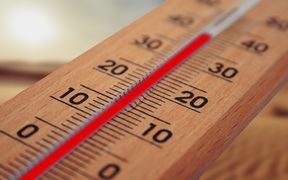Five things everyone should know about cooling and ventilation

Text: Antti Kivimäki
1. Lower temperatures make a room more humid
During last winter’s energy crisis, households were urged to cut back on heating. The optimum indoor air temperature is around 21 °C, and a one-degree reduction decreases heating costs by about 5%. But even if’you don't particularly like it cool, lowering the air temperature has a positive side-effect: as the temperature drops, the relative humidity in the air increases.
The air can be quite dry in the winter, especially during severe frosts, and many people suffer from dry mucous membranes and dry eyes. Lowering the air temperature in a room brings up the relative humidity, which partly alleviates the problem of winter dryness.
2. The reference data for designing buildings is out of date
The maximum summer indoor air temperature is set by regulation. According to the Ministry of Social Affairs and Health, the indoor air temperature in existing buildings must not exceed 32 °C in general and 30 °C for vulnerable groups, such as nursing home residents. The Ministry of the Environment requires that new buildings are designed so that the indoor air temperature does not exceed 27 °C for over 150 degree-hours in the summer.
The problem is that the reference year for the energy calculations is based on measurements taken between 1980 and 2009. This reference year is used to estimate cooling demands and determine thermal conditions – but weather conditions now aren’t the same as in the reference year.
The reference year has six hot days, and new buildings are designed with this in mind. But four of the past ten summers have been especially hot – for example, 2018 had over 30 hot days. The planet is warming, and it’s happening faster in Nordic countries than near the equator.
That means today’s regulations ensure that houses can withstand the summers of the past but not the heatwaves that are common now – let alone the even hotter summers that are coming.
3. Mechanical cooling will be needed in the future
Today, most homes are cooled by increasing the airflow rate of mechanical ventilation, opening the windows at night or closing the blinds during the day. But as summers get warmer and heatwaves become more common, this won’t be enough to keep room temperatures within an acceptable range.
Mechanical cooling is needed to make up the difference. It probably won’t be expensive, since cooling doesn’t take much energy and electricity is usually cheap in Finland in the summer. But cooling equipment, such as an air-source heat pump, will have to be purchased and installed.
In the ILMIRA research project commissioned by the Prime Minister’s office, my colleagues and I investigated the sizing of ventilation systems that buildings need to cope with heatwaves in the current climate. In the final report, we show how much different passive measures, such as solar shading and night ventilation, can reduce indoor temperatures during heatwaves. We also assessed the need for mechanical cooling of buildings in current and future climates.
4. Natural ventilation systems also require maintenance and consume a lot of energy
The noise of mechanical ventilation can irritate many people, making modern natural ventilation an attractive option. But natural ventilation isn’t as simple as you might think.
Natural stack ventilation needs a temperature difference to work: warm indoor air has to rise towards the cold outdoor air. Stack ventilation therefore doesn’t work in the summer, and in the winter it works too well, so it can get draughty inside. To help with this, systems can use a supply air valve with a damper that automatically restricts air flow during severe frosts.
The mechanical damper needs a filter to protect it from dust. The supply vents in all the rooms also have filters, and these need to be replaced a couple of times per year. Replacing the filters costs money, and there’s also some risk if the maintenance company leaves the replacement of the filters to the skill and care of the residents.
Natural ventilation also consumes a lot of energy – in a building with natural ventilation, 30% of the total heating energy is used for air exchange.
5. Cooling and air-conditioning are different things
Cooling and air-conditioning are often used synonymously, but strictly speaking they’re different.
Cooling of living spaces refers to the system used to keep the indoor temperature below the limit in the design conditions. Air-conditioning, on the other hand, refers to systems that can simultaneously adjust a room’s humidity and temperature. This is especially important in hot and humid climates, where controlling a room’s humidity can affect how we perceive its temperature.
Hot weather can turn homes into perilous infernos – researchers are now examining future needs for cooling
A new research project examines the temperatures of buildings and how they affect the comfort level of people – and seeks effective means of cooling that are also easy to employ.

Read more news
Create your CV easily with the Research.fi profile tool
Aalto University’s researchers can now create a CV using the CV tool in the Research tool service. The tool generates an editable Word CV based on your Research.fi profile information, following the official TENK CV template.
Are you tired of bad news?
The Laboratory of Hope exhibition presents ideas for a brighter future from 5th February to 27th March 2026Apply to be a guest professor or visiting researcher at the Université Grenoble Alpes
Unite! partner, Université Grenoble Alpes (UGA) has opened a call to host international professors and researchers for short stays.






